Odisha State Board CHSE Odisha Class 12 Biology Solutions Chapter 1 Reproduction in Organisms Textbook Questions and Answers.
CHSE Odisha 12th Class Biology Chapter 1 Question Answer Reproduction in Organisms
Reproduction in Organisms Class 12 Questions and Answers CHSE Odisha
Very Short Answer Type Questions
Fill in the blanks with correct answer from the choices given in the bracket
Question 1.
Non-motile asexual reproductive units are called …………….. (zoospores, buds, gametes, conidia)
Answer:
conidia
Question 2.
In …………., a living organism divides equationally. (fragmentation, fission, budding, sporulation)
Answer:
fission
Question 3.
Yeast generally reproduces by …………….. .
(fission, budding, sporulation, gametangia)
Answer:
budding
Question 4.
Dahlia propagates by …………… (roots, stem, leaf, seed)
Answer:
roots
Question 5.
The process by which one plant part is inserted into another to grow a new individual plant is called ………….. .
(layering, cutting, grafting, micropropagation)
Answer:
grafting
![]()
Answer each of the following in one word or more words
Question 6.
What is called the motile asexual reproduction units?
Answer:
Zoospores
Question 7.
In which asexual method do yeasts generally divide?
Answer:
Budding
Question 8.
What can be called to sexual reproductive units?
Answer:
Gametes
Question 9.
What is the general asexual method of reproduction in Amoeba?
Answer:
Binary fission
Question 10.
In the process of grafting, what is called to detached part?
Answer:
Scion
Question 11.
In which process can large number of adventitious buds be formed?
Answer:
Micropropagation
Correct the statements without changing underlined words only
Question 12.
In mound layering, branches at lower portion of the stem are put in the soil at many places.
Answer:
In mound layering, the shoot is pruned and lower part is covered by soil, like a mound.
Question 13.
Dahlia reproduces vegetatively by stems.
Answer:
Dahlia reproduces vegetatively by roots.
Question 14.
Aspergillus reproduces asexually by zoospores.
Answer:
Aspergillus reproduces sexually by zoospores.
Question 15.
Internal buds in sponges are called gemma cups.
Answer:
Internal buds in sponges are called gemmules.
Question 16.
In binary fission, many cells can be produced from one cell.
Answer:
In binary fission, two cells can be produced from one cell.
Fill in the blanks
Question 17.
The process of perennation of species takes place by ………
Answer:
encystment
Question 18.
Zoospores are borne inside …………….
Answer:
sporangia
Question 19.
Under unfavourable conditions when a number of tiny Amoeba are produced by multiple fission, it is called …………..
Answer:
multiple fission
Question 20.
Internal buds in Hydra are called …………..
Answer:
endogenous buds.
Question 21.
In Bryophyllum, adventitious buds are borne on …………..
Answer:
leaves
![]()
Short Answer Type Questions
Write notes on the following with at least 2 valid points
Question 1.
Asexual reproduction
Answer:
When offsprings are produced by a single parent without the involvement of gametic fusion, the reproduction is called asexual.
The resultant offsprings are similar to one another and are exact copies of their parents. Such a group of morphologically and genetically similar individuals is called clone.
Question 2.
Micropropagation
Answer:
In this method, the propagation of plants is achieved by culturing the cells, tissues and organs in laboratory. It is called tissue culture. Initially, this forms an undifferentiated mass of cells called callus. Later on, this callus differentiates to produce many small plantlcts. The tcchniquc of micropropagation is similar ro initiating the rooting in plant cuttings.
In a way it can also be called as another method of vegetative propagation in plants. However, it differs from the conventional procedure because ir is carried out under sterile condition and requires an artificial nutrient medium.
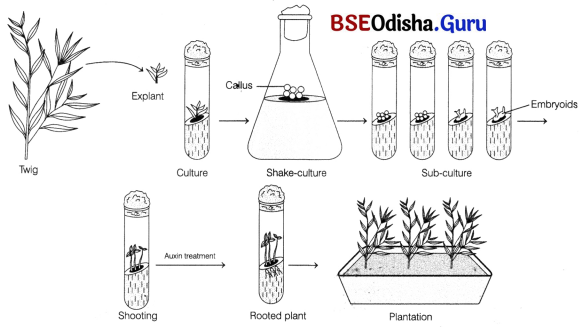
Question 3.
Cutting
Answer:
A small piece of any plant, i.e. stem, root or leaf used for vegetative propagation is called as cutting. In stem cutting, a piece of stem (20-30 cm long) is taken from parent plant. The cutting with nodes and internodes are planted in moist soil having adequate nutrients.
After a few days, roots from basal part and shoots from upper buds can be observed emerging from the planted part. The plants propagated by this method are China rose, Bougainvillea, sugarcane, etc.
Question 4.
Layering
Answer:
Layering
In this method, adventitious roots are artificially induced on the stem branches while they are still attached to the „ plant, e.g. jasmine, grapevine, litchi, orange, etc.
There are three types of layering
- Serpentine layering The basal branches (i.e. lower portions of the stem) are pegged in the soil at several places to form new plants.
- Mound layering In this process, the shoot is pruned and its lower part is covered by soil with the apical portion remaining outwards; in the form of a mound.
After some time, it develops a number of shoots. Among these, rooted ones are separated and planted, e.g. gooseberry and current. - Air layering (gootee) In this method, about 3.5 cm ring of bark is removed from the base of an aerial shoot. This area is then covered by a thick plaster of grafting clay. It consists of hay, cowdung, clay and water with small quantity of root promoting hormone (such as NAA or IBA).
Question 5.
Fission
Answer:
It is the division of the parent body into two or more daughter individuals identical to the parent.
Fission can occur by the following methods
(i) Binary fission It is the division of the parent cell into two small, nearly equal sized daughter individuals, each of which rapidly grows into an adult. It occurs in single-celled animals like bacteria and protozoans, e.g. Amoeba, Paramecium, etc.
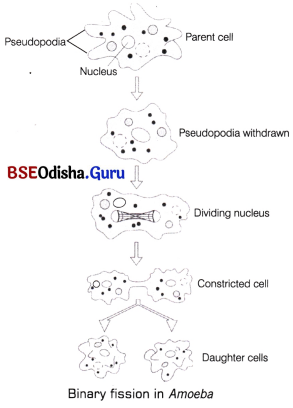
- Simple binary fission When division occurs in any one plane, it is known as simple binary fission, e.g. Amoeba.
- Longitudinal binary fission It takes place when division occurs along the longitudinal axis, e.g. Euglena, Vorticella.
- Transverse binary fission When division occurs along the transverse axis, right angle to the longitudinal axis of the individual, e.g. Paramecium, diatoms, bacteria, Planaria.
- Oblique binary fission When division occurs at an angle to the transverse axis, e.g. Ceratium, Gonyaulax.
![]()
Question 6.
Budding
Answer:
In this process, unequal and small projections called buds are produced from the parent cell. Initially, these buds remain attached to the parent cell and eventually get separated and mature into new organisms, e.g. yeast, Hydra, etc.
Depending on the place from where the bud arises, budding can be of two types
External budding (Hydra and yeast) During favourable conditions like presence of adequate nutrients, moisture, etc., a bud grows on the parent body.
In Hydra (multicellular organism), regenerative cells are used for reproduction during budding.
A bud develops on the median region of the body as an outgrowth. Later, due to the repeated cell divisions, these buds gradually enlarge and coelenteron of Hydra migrates ipto it.
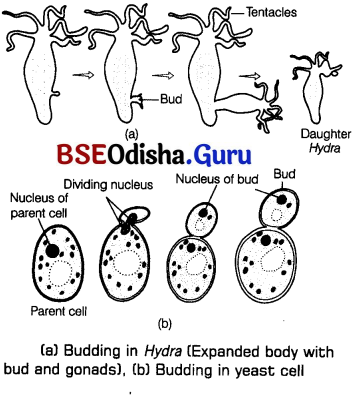
Question 7.
Fragmentation
Answer:
It is the breaking of parental body into distinct pieces, each of which regenerates into an offspring, e.g. Hydra, Planaria, sea stars, Spirogyra, etc.
In economically important horticultural or crop plants, human beings use this method of segregating plant parts for their own benefits.
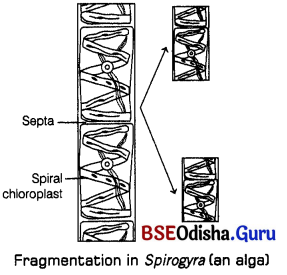
Differentiate between two words in the following pairs of words
Question 1.
Zoospores and Conidia
Answer:
Differences between zoospores and conidia are as follows
| Zoospores | Conidia |
| They are motile asexual structures. | They are immotile asexual structures. |
| They are borne endogenously in sporangia. | They are borne exogenously. |
| They are liberated from sporangium only after it becomes mature, e.g. Ulothrix. | They can be easily disseminated by external agent like air and water, e.g. Penicillium. |
Question 2.
Asexual reproduction and Sexual reproduction
Answer:
Differences between asexual reproduction and sexual reproduction are as follows
| Asexual reproduction | Sexual reproduction |
| It occurs in lower organisms. | It occurs almost in all types of animals and mostly in higher plants. |
| It is always uniparental. | It is usually biparental. |
| Gametes are not formed. | Gametes are always formed. |
| Fertilisation does not take place. | Fertilisation takes place. |
| It involves only mitosis. | It involves both meiosis and mitosis. |
| Young ones are genetically identical to the parents. | Young ones differ genetically from the parents. |
| Multiplication occurs rapidly. | Multiplication is not so rapid as in asexual reproduction. |
| Since there is no variation, so It does not contribute in the evolution of the species. | Since there are variations, soft contributes in the evolution of the species. |
![]()
Question 3.
Grafting and Layering
Answer:
Differences between grafting and layering are as follows
| Grafting | Layering |
| It is a technique of connecting two parts usually a root system and a shoot system. | It is a type of root induction in which adventitious roots are induced to develop on a soft stem. |
| It is useful in obtaining more varieties from a single parent. | It only results in one type of offspring. |
| Highly desirable characters from parents can be obtained. | Same characteristics as of parents occur in offspring. |
| e.g. mango, lemon. | e.g. rose, jasmine. |
Question 4.
Budding and Fission
Answer:
Differences between budding and fission are as follows
| Budding | Fission (Binary) |
| The parent produces a small bud that gradually grows in size and then separates from the parent body. | The parent body divides into two equal and similar halves. Each half forms a new individual. |
| A protuberance (bud) is formed. | A protuberance is not formed. |
| Division is unequal. | Division is equal. |
| Parent body remains intact. | Parent body disappears. |
| e.g. yeast, Sycon, Hydra. | e.g. bacteria, Amoeba, Euglena, Paramecium, Ptanaria. |
Question 5.
Internal budding and External budding
Answer:
Differences between internal budding and external budding are as follows
| Internal budding | External budding |
| Buds are formed within the parent body. | Bud grows externally on parent body. |
| Buds or gemmules come out under favourable conditions and form a new colony. | Bud detaches from parent body and grows into a new individual. |
| e.g. Spongilla. | e.g. Hydra. |
Question 6.
Fragmentation and Budding
Answer:
Differences between fragmentation and budding are as follows
| Fragmentation | Budding |
| Parent body breaks into two or more pieces called fragments. | Parent body produces a small bud exogenously or . endogenously, |
| Parent identity is lost. | Parent remains intact. |
| e.g. flatworms, Marchantia. | e.g. yeast, Sycon. |
Long Answer Type Questions
Question 1.
Give an account of vegetative repoduction in angiosperms.
Answer:
In plants, asexual reproduction is commonly known as vegetative propagation. It is the process of formation of a new plant from detached vegetative parts of the parent plant. These vegetative structures are called vegetative propagules. This process helps in multiplication of seedless plants, e.g. sugarcane, banana, etc. The process is asexual reproduction as it does not involve two parents. Vegetative ‘‘propagation in plants is of two types
Natural Vegetative Propagation
This type of vegetative propagation occurs in plants naturally. A fragment of the mother plant gets separated and forms an independent plant under suitable conditions.
This can take place by the following vegetative propagules
(i) By Roots
The buds present on the roots grow into leafy shoots called slips above the ground and adventitious roots at their bases. Each slip gives rise to a new plant, e.g. sweet potato, Dahlia, guava, yam, Tinospora, etc.
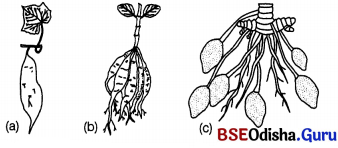
(a) Root tuber of sweet potato, (b) Fasciculated root of Dahlia, (c) Nodulous roots of mango ginger
(ii) By Stems
In plants, vegetative propagation can also take place by stems. They modify themselves to give rise to new plants.
This can take place by the following vegetative propagules
This can take place by the following vegatative propagules
(a) Underground stems Underground modified stems possess buds which grow into new plants.
Some of its types are given below
- Rhizomes These are modified stems with buds and sufficient stored food. A piece of rhizome containing bud can give rise to a new plant. This method is used in the propagation of plants like ginger, turmeric, banana, lotus, etc.
- Bulbs They are highly reduced underground stems with a number of buds, e.g. onion, lilies, garlic, etc.
- Tubers They are the modified underground stem branches having several buds, e.g. each eye of the potato is a bud, which grows into a new potato plant when planted with a portion of swollen tuber. The potato crop is raised by the tubers, not by seeds.
(b) Subaerial stems Vegetative propagation by the means of subaerial stems, can be categorised as given below
- Runners They are modified stems, which produce adventitious roots at nodes. Each node gives rise to an aerial shoot which becomes a new plant, e.g. Oxalis, Centella, grasses, etc.
- Stolons These are horizontal branches that arch above the ground. They also help in vegetative propagation, e.g. strawberry, Vallisneria.
- Suckers They arise from the base of the erect shoot, grow horizontally in the soil and then come out to form new aerial shoots. These shoots become independent when suckers break away from the parent plant, e.g. mint, Chrysanthemum, etc.
- Offsets They are one internode long runners, which develop tuft of leaves at the apex, e.g.
Pistia (water lettuce), Eichhornia (water hyacinth), etc.
(c) Aerial stems Aerial modified stems of cacti develop new plants when the stem segments fall on the ground. These act as the means of vegetative propagation, e.g. Opuntia, etc.
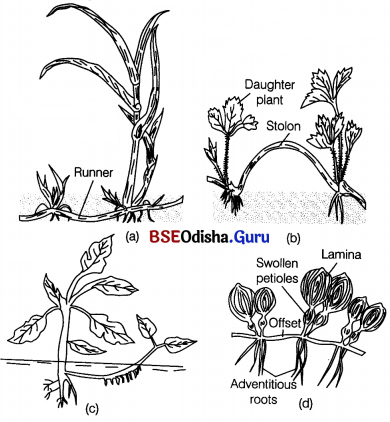
Vegetative reproduction by stem modifications (a) Runner, (b) Stolons, (c) Sucker, (d) Offset
![]()
Question 2.
Describe the process of micropropagation and its advantages.
Answer:
Micropropagatlon
In this method, the propagation of plants is achieved by culturing she cells, tissues and orgun lis Labotatory. It is called ussuc culture, Initially, this forms an undifferentiated mass of cells called calluL Liter on, this callus d.ïffescntiatcs to produce many small plantlets. The technique of micropropaganon is similar to initiating the rooting in plant cuttings.
In a way it can also be called as another method of vegetative propagation in plants. However, it differs from the conventional procedure because it is carried out under sterile condition and requires an artificial nutrient medium.

A set up for micropropagation requires an explant. The most commonly used explants are the meristematic ends of the plants, i.e. stem tip, root tip, axillary bud, etc. This is because meristematic cells have high rate of cell division. These explants, along with culture vessel, cell division media and instruments, etc., are sterilised. The explant is then inoculated into a semi-solid nutrient medium contained in a culture vessel. This is followed by incubation of culture vessel at room temperature. After some time, multiple shoots start developing from the axillary buds. This is called axillary bud proliferation.
Each growing point is subcultured to initiate shooting in callus. This process is called as adventitious shoot formation. Auxin is added in high ratio to stimulate shoot formation. Each shoot inturn develops roots.
A small plantlet is generated, which is later on transferred to an open field for hardening.
Micropropagation is generally practised for many ornamental, fruit and crop plants.
It is considered useful because
- healthy propagules can be obtained from infected parent plants.
- rapid rate of multiplication of plantlets.
- plant material with desired trait and its maintenance in a small space can be easily achieved.
Also, considerable progress in commercial harvesting of medicinal plants such as Dioscorea deltoidea, D. floribunda, Atropa belladona, Solanum sp., Rauwolfia serpentina, etc., has been observed by utilising micropropagation techniques.
Examples of Micropropagation
This process is used in the production of crops such as tea, coffee, oil palm, date palm, coconut, fruit yielding plants like papaya, banana, Citrus and apples in large numbers.
Significant improvement have been achieved in developing protocols for micropropagation of tree species. Mass propagation in vitro of teak, Eucalyptus sp., sandal wood, different species of bamboo and many other trees has been successfully done.
Advantages of Micropropagation
1. Certain species of potato, Cassava, sugarcane and banana have been observed to be severely and chronically affected by pathogenic viruses. Due to this, their yields have reduced considerably. Their yields can be increased significantly by micropropagation which can be used to produced disease-free stocks from infected parent plants.
2. Potato is susceptible to many viral pathogens, some of which may be present without perceptible, symptoms. Eradication of viruses can be achieved by employing micropropagation techniques where healthy meristematic buds are .cultured.
More than 500 plants can be obtained in about 3-4 months starting from a single meristem. By varying the medium composition, light intensity and temperature, plantlets can be induced to . produce microtubers.
These disease-free microtubers can be grown under controlled conditions in soil to form minitubers. These minitubers can be planted directly in the field to raise a disease-free crop.
3. Apart from these applications of micropropagation, techniques for generating true-to type planting, material from elite genotypes, micropropagation holds special significance in situations where rapid accumulation of extremely limited stock material is required.
The desired genetic gains achieved through plant breeding can be multiplied several folds on an economic and rapid time scale.
Question 3.
Describe the process of asexual reproduction in lower animals.
Answer:
Asexual Reproduction:
When the offspring is produced by a single parent without the involvement of gamete formation, the reproduction is called as asexual reproduction.
Properties of Asexual Reproduction
The properties of asexual reproduction are as follows
- Offsprings produced by asexual reproduction are identical to one another and exact copies of their parents. The term clone is used to describe such morphologically and genetically similar individuals.
- Asexual reproduction occurs in plants, protozoans and some lower animals such as sponges, coelenterates, certain worms and tunicates.
- It is absent among the higher non-vertebrates and all vertebrates.
- Asexual reproduction is common among single-celled organisms and animals with relatively simple organisation.
- In protists and monerans, the organism or the parent cell divides into two, to give rise to new individuals. Thus, in these organisms cell division is itself a mode of reproduction.
- It involves only mitotic cell division. Meiosis does not occur in asexual reproduction.
Modes of Asexual Reproduction
It takes place by the following methods
Fission
It is the division of the parent body into two or more daughter individuals identical to the parent.
Fission can occur by the following methods
(i) Binary fission It is the division of the parent cell into two small, nearly equal sized daughter individuals, each of which rapidly grows into an adult. It occurs in single-celled animals like bacteria and protozoans, e.g. Amoeba, Paramecium, etc.

Binary fission is of following types
- Simple binary fission When division occurs in any one plane, it is known as simple binary fission, e.g. Amoeba.
- Longitudinal binary fission It takes place when division occurs along the longitudinal axis,
e.g. Euglena, Vorticella. - Transverse binary fission When division occurs along the transverse axis, right angle to the longitudinal axis of the individual, e.g. Paramecium, diatoms, bacteria, Planaria.
- Oblique binary fission When division occurs at an angle to the transverse axis, e.g. Ceratium, Gonyaulax.
(ii) Multiple fission It is the division of the parent body into many small daughter individuals simultaneously, e.g. Plasmodium, (the malarial parasite), Amoeba (during unfavourable conditions), Stanieria (an alga), etc.
At the onset of unfavourable conditions, like drying of water reservoir, extreme hot, drought, scarcity of food or condensation of water into ice, Amoeba withdraws its pseudopodia, becomes spherical and encloses itself within the 2-3 layered strong envelope. This process is known as encystment. During this phase, the metabolism of Amoeba is reduced to the minimum.
However, the nucleus divides repeatedly to form a large number of nuclei. Each nucleus remains surrounded by a small amount of cytoplasm. When the favourable environmental condition sets in the outer environment, the prolectin cyst disintegrates and premature daughter Amoeba called amoebae gets released.
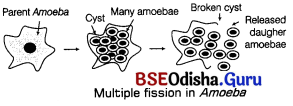
Multiple fission in Amoeba Spoliation
Sometimes the products of multiple fission become individually surrounded by resistant coats, i.e. cyst walls before their release from parent, the process is known as sporulation and the encysted products are known as spores.
It is not only the fastest method of reproduction but also helps to overcome unfavourable conditions. Sporulation is generally found in monerans, protistans, algae and lower fungi.
Different organisms produce different types of spores as given below
(i) Zoospores They are microscopic motile structures with one or two flagella. The flagella help the zoospores to swim in aquatic habitat for proper dispersal.
These are the most common reproductive structures seen in the members of kingdom-Fungi and simple plants such as algae, e.g. Chlamydomonas, Albugo, Ulothrix, Saprolegnia (lower fungi), etc.
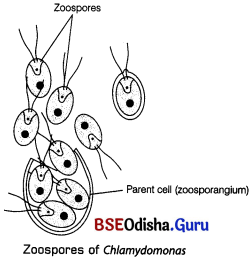
(ii) Conidia They are non-motile, exogenous spores, which develop through constriction on the tips of the conidiophore in fungi, e.g. PeniciUium, Aspergillus, etc.
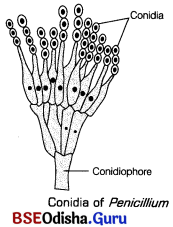
Conidia of PeniciUium
Budding
In this process, unequal and small projections called buds are produced from the parent cell. Initially, these buds remain attached to the parent cell and eventually get separated and mature into new organisms, e.g. yeast,
Hydra, etc.
Depending on the place from where the bud arises, budding can be of two types
(i) External budding (Hydra and yeast) During favourable conditions like presence of adequate nutrients, moisture, etc., a bud grows on the parent body.
In Hydra (multicellular organism), regenerative cells are used for reproduction during budding.
A bud develops on the median region of the b«dy as an outgrowth. Later, due to the repeated cell divisions, these buds gradually enlarge and coelenteron of Hydra migrates ipto it.
Tentacles start developing at the terminal region of the bud’s mouth. These buds develop into tiny individuals which on getting fully matured, detach themselves from the parent body and become new independent individuals.
The same process occurs in yeast. The cell wall of parent bulges out as an outgrowth at the peripheral region and is called bud. The parent nucleus divides along with the cytoplasm and the newly formed ‘ nucleus migrates into the new bud which gets detached from the parent yeast.

(ii) Internal budding (Gemmule formation) Under the adverse conditions, several sponges form internal buds. These internal buds are called gemmules.
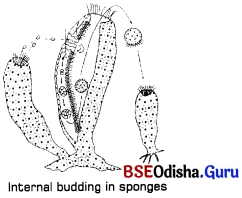
In this process, archaeocytes a special type of totipotent cells aggregate together and a hard coat is formed around them. It remains open to outside via a small pore, i.e. micropyle.
During favourable environmental conditions, a mass of archaeocytes comes out via micropyle (a minute pore) that grows into a colony, e.g. Spongilla, etc.
Question 4.
Describe the process of asexual reproduction in lower plants.
Answer:
In plants, asexual reproduction is commonly known as vegetative propagation. It is the process of formation of a new plant from detached vegetative parts of the parent plant. These vegetative structures are called vegetative propagules. This process helps in multiplication of seedless plants, e.g. sugarcane, banana, etc. The process is asexual reproduction as it does not involve two parents. Vegetative ‘‘propagation in plants is of two types
Natural Vegetative Propagation
This type of vegetative propagation occurs in plants naturally. A fragment of the mother plant gets separated and forms an independent plant under suitable conditions.
This can take place by the following vegetative propagules
(i) By Roots
The buds present on the roots grow into leafy shoots called slips above the ground and adventitious roots at their bases. Each slip gives rise to a new plant, e.g. sweet potato, Dahlia, guava, yam, Tinospora, etc.

(a) Root tuber of sweet potato, (b) Fasciculated root of Dahlia, (c) Nodulous roots of mango ginger
(ii) By Stems
In plants, vegetative propagation can also take place by stems. They modify themselves to give rise to new plants.
This can take place by the following vegetative propagules
This can take place by the following vegatative propagules
(a) Underground stems Underground modified stems possess buds which grow into new plants.
Some of its types are given below
- Rhizomes These are modified stems with buds and sufficient stored food. A piece of rhizome containing bud can give rise to a new plant. This method is used in the propagation of plants like ginger, turmeric, banana, lotus, etc.
- Bulbs They are highly reduced underground stems with a number of buds, e.g. onion, lilies, garlic, etc.
- Tubers They are the modified underground stem branches having several buds, e.g. each eye of the potato is a bud, which grows into a new potato plant when planted with a portion of swollen tuber. The potato crop is raised by the tubers, not by seeds.
(b) Subaerial stems Vegetative propagation by the means of subaerial stems, can be categorised as given below
- Runners They are modified stems, which produce adventitious roots at nodes. Each node gives rise to an aerial shoot which becomes a new plant, e.g. Oxalis, Centella, grasses, etc.
- Stolons These are horizontal branches that arch above the ground. They also help in vegetative propagation, e.g. strawberry, Vallisneria.
- Suckers They arise from the base of the erect shoot, grow horizontally in the soil and then come out to form new aerial shoots. These shoots become independent when suckers break away from the parent plant, e.g. mint, Chrysanthemum, etc.
- Offsets They are one internode long runners, which develop tuft of leaves at the apex, e.g.
Pistia (water lettuce), Eichhornia (water hyacinth), etc.
(c) Aerial stems Aerial modified stems of cacti develop new plants when the stem segments fall on the ground. These act as the means of vegetative propagation, e.g. Opuntia, etc.

Vegetative reproduction by stem modifications (a) Runner, (b) Stolons, (c) Sucker, (d) Offset
